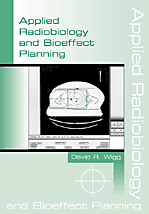
Applied Radiobiology and Bioeffect Planning
Author: David WiggISBN: 9781930524057 ISBN10: 1930524056
Published: 2001 | 486 | Hardcover
OUT OF PRINT
Table of Contents
CHAPTER 1 EARLY MODELS OF CLINICAL IMPORTANCE "WRONG BUT USEFUL MODELS"
1.1 Introduction
1.2 Derivation Of Power Law Models And Time Dose Fractionation Models
1.3 Dose Per Fraction Planning
1.4 The Cell Population Kinetic Model (CPK)
1.5 Basic Theory And Limitations Of Linear-Quadratic Formalisms
1.6 Summary
CHAPTER 2 THE VOLUME EFFECT
2.1 Introduction
2.2 Volume Effect Models And Adaptations For Bioeffect Planning
2.3 The Clinical Significance Of The Volume Effect
2.4 Clinical Applications Of The Volume Effect
2.5 Three Dimensional Computer Plans And Dose-Volume Histograms
2.6 Summary
CHAPTER 3 ADAPTATIONS OF THE L-Q MODEL FOR BIOEFFECT PLANNING OF FRACTIONATED AND CONTINUOUS IRRADIATION
3.1 Introduction
3.2 Fractionated Radiotherapy
3.3 Continuous Irradiation
3.4 Repair Rates And The Relationship Between Repair Rates And Radiosensitivity Parameters In Continuous Irradiation
3.5 Modification Of L-Q Formalisms For Bioeffect Planning Of Combined
Continuous And Fractionated Treatment
3.6 Summation Of Different Schedules Of Continuous Irradiation
3.7 The Determination Of Tumor Control Probability Following Fractionated
Radiotherapy
3.8 Summary
CHAPTER 4 HYPERFRACTIONATION AND INCOMPLETE REPAIR
4.1 Introduction
4.2 The Incomplete Repair Factor
4.3 Biological Equivalence of Hyperfractionated and Daily Treatment
4.4 Limitations Of Predictive Models
4.5 Prediction Of Tumor Control Probability
4.6 Summary
CHAPTER 5 COMBINED CHEMO/RADIOTHERAPY
5.1 Introduction
5.2 Combined Chemo/Radiotherapy Effects On Normal Tissues
5.3 Combined Chemotherapy And Fractionated Irradiation
5.4 Combined Chemotherapy And Low Dose Rate Irradiation
5.5 Summary
CHAPTER 6 THE EFFECTS OF TIME AND REPOPULATION DURING THE TREATMENT PERIOD ON TISSUE RESPONSES, TUMOR CONTROL PROBABILITY AND OPTIMUM FRACTIONATION
6.1 Introduction
6.2 Fractionated Treatment And Tumor Repopulation
6.3 Continuous Irradiation And Tumor Repopulation
6.4 Summary
CHAPTER 7 A RADIOBIOLOGICAL BASIS FOR THE TREATMENT OF
ARTERIOVENOUS MALFORMATIONS
7.1 Introduction
7.2 The Radiobiology Of Brain Tissue Treated With Stereotactic Techniques
7.3 The Radiobiology Of Arteriovenous MalformationsObliteration
7.4 Discussion And Summary
Appendix To Chapter 7
CHAPTER 8 PLAUSIBLE PARAMETER VALUES OF NORMAL TISSUES AND TUMORS THAT MAY BE USED FOR PREDICTIVE MODELS AND BIOEFFECT PLANNING
8.1 Introduction
8.2 Tumor Radiosensitivity Parameters Of Predictive Value
8.3 S2 Values
8.4 Intrinsic Radiosensitivity Defined By And Values And Their Relevance
For Predictive Assays
8.5 In-Vivo , And S2 Radiosensitivity Parameters Of Human Tumors
8.6 Radiosensitivity Of Normal Late Reacting Tissues
8.7 The Tissue Specific Volume Exponent () Of Normal Late Reacting Tissue
8.8 The Normalized Dose-Response Gradient ()
8.9 Proliferation Rates Of Human Tumors
8.10 The Number Of Clonogens In Human Tumors
8.11 Dose Per Fraction
8.12 Plausible Radiosensitivity, Tumor And Treatment Variables
8.13 Summary
CHAPTER 9 TUMOR CONTROL AND LATE EFFECT PREDICTIVE MODELS AND THEIR CLINICAL APPLICATIONS
9.1 Introduction
9.2 Derivation Of Tumor Control Dose/Effect Curves Using A.Linear- Quadratic Based
Model For Fractionated Treatment
9.3 Means Of Quantifying Inhomogeneity Effects
9.4 Derivation Of Tumor Control Dose/Effect Curves Using A Survival Fraction
At 2.0 Gy (S2) Model
9.5 Derivation Of Normal Tissue Dose/Effect Curves (The Effect Model)
9.6 Applications Of The Effect Model To Compare Tumor Control Probability
And Late Reacting Normal Tissue Effects
9.7 Steepness Of Dose Response Curves
9.8 Optimum Fractionation For Fractionated Treatments (The Optimum Model)
9.9 Some Applications Of The Effect Model
9.10 Optimum Fractionation
9.11 Derivation Of Dose Enhancement Factors Of Cytotoxic Drugs On Normal Tissues
And Tumors Using The Effect Model With Bioeffect Planning
9.12 Estimates Of Statistical Power And Sample Size Required For Clincal Trials
Using The Effect Or Optimum Models
9.13 Tumor Control Probability Prediction Models For Continuous Irradiation
(The Confract Model)
9.14 The Use Of The Confract Model To Examine The Interaction Between Normal
Late Reacting Tissue And Tumor Variables When Treating With Continuous
Irradiation
9.15 The Use Of The Confract Model To Evaluate Predicted Tumor Control
Probabilities Following Continuous And Continuous Combined With
Fractionated Treatment For Comparison With Clinical Results
9.16 Summary
CHAPTER 10 EXAMPLES OF CLINICAL APPLICATIONS OF BIOEFFECT PLANNING
10.1 Introduction
10.2 Impediments To The Development Of Bioeffect Planning
10.3 A Teaching Tool. Display Of "Live" Interactive Models
10.4 The First Step To Bioeffect Planning In The Clinic. Dose Per Fraction Display Plots
10.5 Examples Of Bioeffect Plans
10.6 Published Papers On Bioeffect Planning By The Author
10.7 Summary
APPENDICES A, B, C
In appendices A, B, C are more examples of bioeffect plans, basic theory and descriptions of the limitations of isodose planning.
GLOSSARY
BIBLIOGRAPHY
INDEX


